Related Research Articles

Aphra Behn was an English playwright, poet, prose writer and translator from the Restoration era. As one of the first English women to earn her living by her writing, she broke cultural barriers and served as a literary role model for later generations of women authors. Rising from obscurity, she came to the notice of Charles II, who employed her as a spy in Antwerp. Upon her return to London and a probable brief stay in debtors' prison, she began writing for the stage. She belonged to a coterie of poets and famous libertines such as John Wilmot, Lord Rochester. Behn wrote under the pastoral pseudonym Astrea. During the turbulent political times of the Exclusion Crisis, she wrote an epilogue and prologue that brought her legal trouble; she thereafter devoted most of her writing to prose genres and translations. A staunch supporter of the Stuart line, Behn declined an invitation from Bishop Burnet to write a welcoming poem to the new king William III. She died shortly after.

Thomas Southerne was an Irish dramatist.
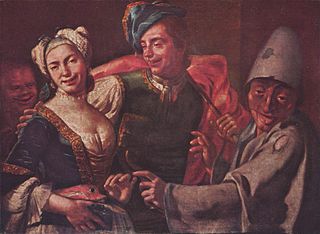
The Rover or The Banish'd Cavaliers is a play in two parts that is written by the English author Aphra Behn. It is a revision of Thomas Killigrew's play Thomaso, or The Wanderer (1664), and features multiple plot lines, dealing with the amorous adventures of a group of Englishmen and women in Naples at Carnival time. According to Restoration poet John Dryden, it "lacks the manly vitality of Killigrew's play, but shows greater refinement of expression." The play stood for three centuries as "Behn's most popular and most respected play."
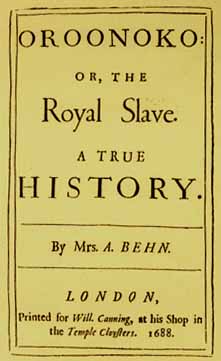
Oroonoko: or, the Royal Slave is a work of prose fiction by Aphra Behn (1640–1689), published in 1688 by William Canning and reissued with two other fictions later that year. It was also adapted into a play. The eponymous hero is an African prince from Coramantien who is tricked into slavery and sold to European colonists in Surinam where he meets the narrator. Behn's text is a first-person account of Oroonoko's life, love, rebellion, and execution.
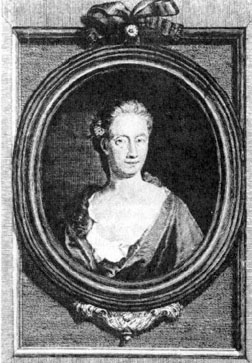
Eliza Haywood, born Elizabeth Fowler, was an English writer, actress and publisher. An increase in interest and recognition of Haywood's literary works began in the 1980s. Described as "prolific even by the standards of a prolific age", Haywood wrote and published over 70 works in her lifetime, including fiction, drama, translations, poetry, conduct literature and periodicals. Haywood today is studied primarily as one of the 18th-century founders of the novel in English.

Love in Excess (1719–1720) is Eliza Haywood's best known novel. It details the amorous escapades of Count D'Elmont, a rake who becomes reformed over the course of the novel. Love in Excess was a huge bestseller in its time, going through multiple reissues in the four years following its initial publication. It was once compared in terms of book sales with Gulliver's Travels and Robinson Crusoe. This information was later shown to be incorrect; the novel selling only about 6000 copies over 23 years.
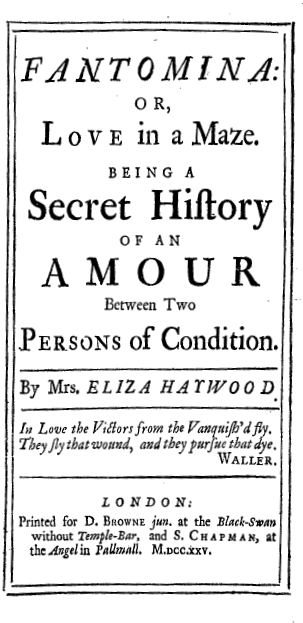
Amatory fiction is a genre of British literature that became popular during the late 17th century and early 18th century, approximately 1660–1730. It was often spread throughout coteries, published while trying to remain true to the writer's vision without criticism. Amatory fiction predates, and in some ways predicts, the invention of the novel and is an early predecessor of the romance novel. Indeed, many themes of the contemporary romance novel were first explored in amatory fiction. The writing of amatory fiction work was dominated by women, and it was considered to have mainly female readers; but it is assumed that men read these novels as well. As its name implies, amatory fiction is preoccupied with sexual love and romance. Most of its works were short stories.

María de Zayas y Sotomayor wrote during Spain's Golden Age of literature. She is considered by a number of modern critics as one of the pioneers of literary feminism, while others consider her simply a well-accomplished baroque author. The female characters in de Zayas's stories were used as vehicles to enlighten readers about the plight of women in Spanish society, or to instruct them in proper ways to live their lives.
Janet Margaret Todd is a British academic and author. She was educated at Cambridge University and the University of Florida, where she undertook a doctorate on the poet John Clare. Much of her work concerns Mary Wollstonecraft, Jane Austen, and their circles.
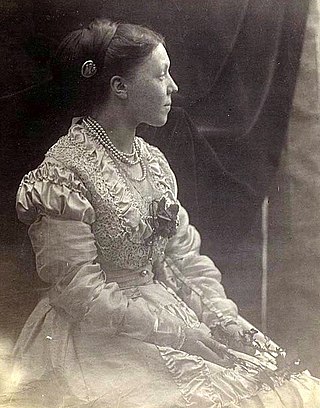
Anne Isabella, Lady Ritchie, eldest daughter of William Makepeace Thackeray, was an English writer, whose several novels were appreciated in their time and made her a central figure on the late Victorian literary scene. She is noted especially as the custodian of her father's literary legacy, and for short fiction that places fairy tale narratives in a Victorian milieu. Her 1885 novel Mrs. Dymond introduced into English the proverb, "Give a man a fish and you feed him for a day; teach a man to fish and you feed him for life."
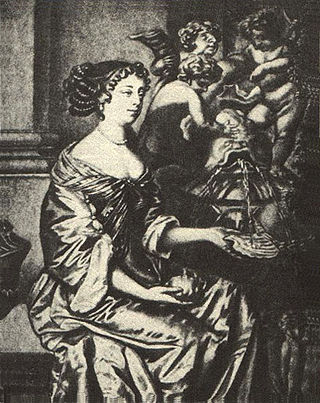
Mary Saunderson (1637–1712), later known as Mary Saunderson Betterton after her marriage to Thomas Betterton, was an actress and singer in England during the 1660s and 1690s. She is considered one of the first English actresses.

Love-Letters Between a Nobleman and His Sister is a three-volume roman à clef by Aphra Behn playing with events of the Monmouth Rebellion and exploring the genre of the epistolary novel. The first volume, published in 1684, lays some claim to be the first English novel. Some scholars claim that the attribution to Behn remains in dispute. The novel is "based loosely on an affair between Ford, Lord Grey of Werke, and his wife's sister, Lady Henrietta Berkeley, a scandal that broke in London in 1682". It was originally published as three separate volumes: Love-Letters Between a Noble-Man and his Sister (1684), Love-Letters from a Noble Man to his Sister: Mixt with the History of Their Adventures. The Second Part by the Same Hand (1685), and The Amours of Philander and Silvia (1687). The copyright holder was Joseph Hindmarsh, later joined by Jacob Tonson.
Nationality words link to articles with information on the nation's poetry or literature.

Fantomina; or, Love in a Maze is a novel by Eliza Haywood published in 1725. In it, the protagonist disguises herself as four different women in her efforts to understand how a man may interact with each individual persona. Part of the tradition of amatory fiction is to rewrite the story of the persecuted maiden into a story of feminine power and sexual desire.

The Fair Jilt: or, the Amours of Prince Tarquin and Miranda is a short novella by Aphra Behn published by Will Canning in 1688, a year before Behn's death. The plot is loosely based around rumors Behn had heard regarding a story of Prince Francisco de Tarquini. Though Behn did insist that the story was true, it is sensationalized. The story follows a woman named Miranda who, slighted by the rejection of a priest, accuses him of rape. After Miranda marries Prince Tarquin, the story observes their series of deceptive acts and multiple murder attempts instigated by the passions of love and desire. The Fair Jilt occupies itself with themes of deceit, infatuation, and impassioned acts of love, common ideas within the amatory fiction genre. Behn herself introduces the story as a study of the destructive power of love.

Forced seduction is a theme found frequently in Western literature wherein man-on-woman rape eventually turns into a genuine love affair. A popular example is Luke and Laura from the American soap opera General Hospital.
The Forc'd Marriage; or, The Jealous Bridegroom is a play by Aphra Behn, staged by the Duke's Company on 20 September 1670 in Lincoln's Inn Fields, London, England. This sex tragicomedy ran for six nights, which granted Behn the house profits for both the third and six nights. It is considered her first staged play. Thomas Otway played a "probation part."
The False Count, Or, A New Way to play An Old Game is a comedic play written by Aphra Behn, first performed in 1681 and published in 1682. It was staged by the Duke's Company at the Dorset Garden Theatre in London. The cast included William Smith as Don Carlos, James Nokes as Francisco, John Freeman as Sebastian, John Wiltshire as Antonio, George Bright as Baltazer, Cave Underhill as Guzman, Anthony Leigh as Guilion, Elizabeth Currer as Isabella and Margaret Osborne as Jacinta.

Sir Patient Fancy: A Comedy, is a comedic play written by Aphra Behn, first performed in 1678. It is Behn's first overtly political play. It was staged by the Duke's Company at the Dorset Garden Theatre in London with a cast that included Nell Gwyn as Lady Knowell, Anthony Leigh as Sir Patient Fancy, John Crosby as Leander Fancy, Thomas Betterton as Wittmore, William Smith as Lodwick Knowell, James Nokes as Sir Credulous Easy, John Richards as Curry, Elizabeth Currer as Lady Fancy, Mary Betterton as Isabella, Emily Price as Lucretia and Anne Shadwell as Maundy.
Rosalind Ballaster is a scholar of 18th-century literature and a specialist in Georgian theatre. A Professor at Mansfield College, Oxford, she is a winner of the British Academy's Rose Mary Crawshay Prize for 2006.
References
- 1 2 Hultquist, Aleksondra (2015). "Adapting Desires in Aphra Behn's The History of the Nun". The Eighteenth Century. 56 (4): 485–506 (485). doi:10.1353/ecy.2015.0035. ISSN 1935-0201. S2CID 163131573.
- 1 2 Goulding, Susan (1 January 2008). "Aphra Behn's "Stories of Nuns": Narrative Diversion and "Sister Books"". Interdisciplinary Literary Studies. 10 (1): 38–55. doi: 10.2307/41210004 . JSTOR 41210004. S2CID 246579583.
- ↑ Mathews, Elizabeth (2012). "'A Strange Sympathy': The Rhetoric of Emotion in The History of the Nun; or, The Fair Vow-Breaker". ABO: Interactive Journal for Women in the Arts, 1640–1830. 2 (1): 2. doi: 10.5038/2157-7129.2.1.4 . ISSN 2157-7129.
